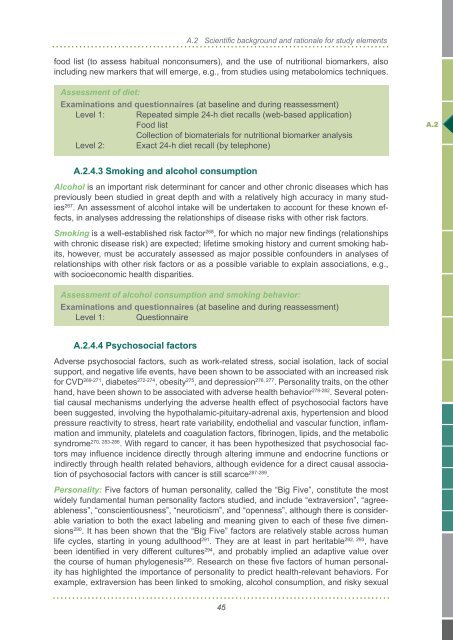Scientific Concept of the National Cohort (status ... - Nationale Kohorte
Scientific Concept of the National Cohort (status ... - Nationale Kohorte
Scientific Concept of the National Cohort (status ... - Nationale Kohorte
Create successful ePaper yourself
Turn your PDF publications into a flip-book with our unique Google optimized e-Paper software.
A.2 <strong>Scientific</strong> background and rationale for study elements<br />
food list (to assess habitual nonconsumers), and <strong>the</strong> use <strong>of</strong> nutritional biomarkers, also<br />
including new markers that will emerge, e.g., from studies using metabolomics techniques.<br />
Assessment <strong>of</strong> diet:<br />
Examinations and questionnaires (at baseline and during reassessment)<br />
Level 1: Repeated simple 24-h diet recalls (web-based application)<br />
Food list<br />
Collection <strong>of</strong> biomaterials for nutritional biomarker analysis<br />
Level 2: Exact 24-h diet recall (by telephone)<br />
A.2.4.3 Smoking and alcohol consumption<br />
Alcohol is an important risk determinant for cancer and o<strong>the</strong>r chronic diseases which has<br />
previously been studied in great depth and with a relatively high accuracy in many studies<br />
267 . An assessment <strong>of</strong> alcohol intake will be undertaken to account for <strong>the</strong>se known effects,<br />
in analyses addressing <strong>the</strong> relationships <strong>of</strong> disease risks with o<strong>the</strong>r risk factors.<br />
Smoking is a well-established risk factor 268 , for which no major new findings (relationships<br />
with chronic disease risk) are expected; lifetime smoking history and current smoking habits,<br />
however, must be accurately assessed as major possible confounders in analyses <strong>of</strong><br />
relationships with o<strong>the</strong>r risk factors or as a possible variable to explain associations, e.g.,<br />
with socioeconomic health disparities.<br />
Assessment <strong>of</strong> alcohol consumption and smoking behavior:<br />
Examinations and questionnaires (at baseline and during reassessment)<br />
Level 1: Questionnaire<br />
A.2.4.4 Psychosocial factors<br />
Adverse psychosocial factors, such as work-related stress, social isolation, lack <strong>of</strong> social<br />
support, and negative life events, have been shown to be associated with an increased risk<br />
for CVD 269-271 , diabetes 272-274 , obesity 275 , and depression 276, 277 . Personality traits, on <strong>the</strong> o<strong>the</strong>r<br />
hand, have been shown to be associated with adverse health behavior 278-282 . Several potential<br />
causal mechanisms underlying <strong>the</strong> adverse health effect <strong>of</strong> psychosocial factors have<br />
been suggested, involving <strong>the</strong> hypothalamic-pituitary-adrenal axis, hypertension and blood<br />
pressure reactivity to stress, heart rate variability, endo<strong>the</strong>lial and vascular function, inflammation<br />
and immunity, platelets and coagulation factors, fibrinogen, lipids, and <strong>the</strong> metabolic<br />
syndrome 270, 283-286 . With regard to cancer, it has been hypo<strong>the</strong>sized that psychosocial factors<br />
may influence incidence directly through altering immune and endocrine functions or<br />
indirectly through health related behaviors, although evidence for a direct causal association<br />
<strong>of</strong> psychosocial factors with cancer is still scarce 287-289 .<br />
Personality: Five factors <strong>of</strong> human personality, called <strong>the</strong> “Big Five”, constitute <strong>the</strong> most<br />
widely fundamental human personality factors studied, and include “extraversion”, “agreeableness”,<br />
“conscientiousness”, “neuroticism”, and “openness”, although <strong>the</strong>re is considerable<br />
variation to both <strong>the</strong> exact labeling and meaning given to each <strong>of</strong> <strong>the</strong>se five dimensions<br />
290 . It has been shown that <strong>the</strong> “Big Five” factors are relatively stable across human<br />
life cycles, starting in young adulthood 291 . They are at least in part heritable 292, 293 , have<br />
been identified in very different cultures 294 , and probably implied an adaptive value over<br />
<strong>the</strong> course <strong>of</strong> human phylogenesis 295 . Research on <strong>the</strong>se five factors <strong>of</strong> human personality<br />
has highlighted <strong>the</strong> importance <strong>of</strong> personality to predict health-relevant behaviors. For<br />
example, extraversion has been linked to smoking, alcohol consumption, and risky sexual<br />
45<br />
A.2



